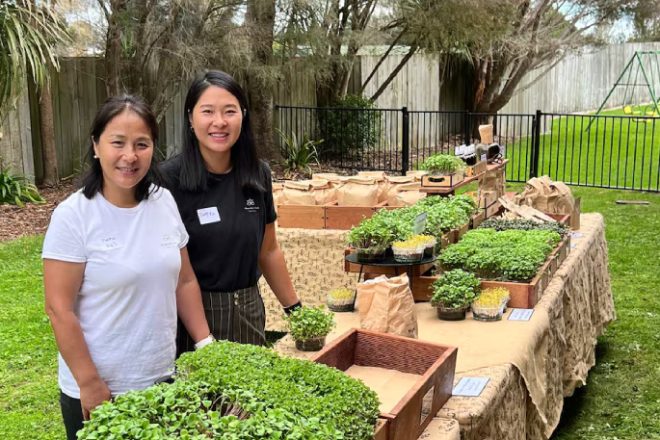마마 칼리스 팜의 설립자인 칼리와 지앙유는 마이크로그린에 대한 열정이 넘칩니다.그들은 이 작은 채소들이 단순히 멋진 장식 그 이상이라고 믿습니다.모녀 팀은 2022년 Te Puke에서 사업을 시작했으며 빠르게 성장했습니다.15제곱미터의 작은 부지로 시작하여 현재는 72제곱미터의 농장을 운영하고 있으며 매주 최소 250개의 트레이의 마이크로그린을 심고 있습니다.
이들의 매출도 크게 증가했습니다.처음에는 주당 40패킷의 마이크로그린을 판매했으며 현재는 매주 1,300패킷 이상을 판매하고 있습니다.마이크로그린은 영양분이 풍부한 어린 채소입니다.비타민과 칼슘과 같은 미네랄이 풍부하기 때문에 숙성 채소보다 건강에 좋다고 알려져 있습니다.
Kali와 Jiangyu는 항상 정원 가꾸기를 좋아했으며 실내 및 식용 식물이 300종 이상 자라고 있습니다.장규는 코로나19 팬데믹 기간 동안 실내 식물 사업에서 일자리를 잃었고 칼리는 은퇴했다.이로 인해 그들은 농업 사업을 시작하게 되었습니다.농산물 재배부터 수확, 포장, 판매에 이르기까지 모든 것을 직접 처리합니다.
이 듀오는 친환경 농업을 위해 최선을 다하고 있습니다.채소에 스프레이나 화학 약품을 사용하지 않고, 물 사용량에 신경을 쓰며, 기계를 사용하지 않고 모든 트레이를 손으로 수확합니다.또한 자연광을 이용해 마이크로그린을 키우고 발아 단계에서만 난방 시스템을 사용합니다.
손으로 수확하는 것은 노동 집약적일 수 있지만 Jiangyu는 손으로 수확하는 것이 농산물의 품질을 보장한다고 말합니다.그녀는 손으로 쟁반을 수확하는 데 5분이 걸리는데, 기계를 사용할 때는 15초가 걸린다고 설명합니다.하지만 포장하는 채소의 품질을 다시 한 번 확인할 수 있다는 점에서 이 접근 방식을 자랑스럽게 생각합니다.그들의 마이크로그린은 보통 일주일 이상 신선하게 유지됩니다.
회사 이름인 마마 칼리스 팜 (Mama Kali’s Farm) 은 이 둘이 내면의 농담으로 지어낸 것입니다. 칼리의 집 뒷마당에 넓은 채소밭이 있기 때문이죠.그들은 함께 일하고 서로에게서 배우는 것을 즐깁니다.
그들의 제품은 현재 뉴 월드, 팍앤세이브, 프레시 초이스를 포함하여 베이 오브 플렌티와 혹스베이 지역의 약 25개 슈퍼마켓에서 판매되고 있습니다.그들의 목표는 재고 네트워크를 전국의 다른 슈퍼마켓으로 확장하는 것입니다.
Jiangyu는 다른 사람들에게도 마이크로그린 재배를 시도해 보라고 권합니다.그녀는 땅이나 물이 많이 필요하지 않으며 식물이 빨리 자란다고 말합니다.부엌 벤치에서 키울 수 있으며 일주일에 한 번만 물을 주면 됩니다.그녀는 마이크로그린을 키우는 것이 재미있고 쉬우며 건강에도 좋다고 덧붙입니다.





























































